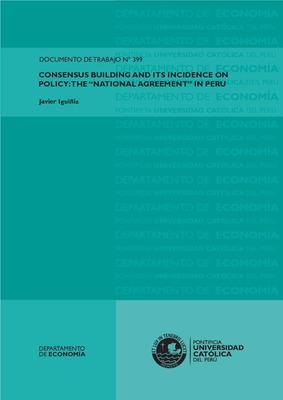| dc.contributor.author | Iguiñiz, Javier | |
| dc.date.accessioned | 2016-02-17T21:37:53Z | |
| dc.date.available | 2016-02-17T21:37:53Z | |
| dc.date.issued | 2015 | |
| dc.identifier.uri | http://repositorio.pucp.edu.pe/index/handle/123456789/52508 | |
| dc.description.abstract | Tras la presentación de algunos interrogantes sobre la efectividad de las instituciones democráticas para cambiar la sociedad, en la segunda sección presentamos la composición y características del Foro del Acuerdo Nacional y el tipo de acuerdos a los que se ha llegado en los doce años desde su fundación. En la tercera sección, recogemos sintéticos elementos teóricos en Sen sobre la conexión entre valores y actividad política que respaldan la existencia de un potencial impacto de los acuerdos consensuales en políticas estatales y prácticas gremiales. En la cuarta sección presentamos los resultados de las respuestas de tomadores de decisiones públicas y gremiales y diversos líderes de opinión a la pregunta sobre la incidencia de las Políticas de Estado en sus decisiones. De esta manera, se obtiene una primera visión de la incidencia de las orientaciones y valores presentes en las 34 Políticas de Estado. | es_ES |
| dc.description.abstract | This article aims to present the composition and characteristics of the operation and show evidence of the impact of consensually agreed “State Policies” by the National Agreement Forum on government policy in Peru over the past decade. After opening questions about the effectiveness of democratic institutions to change society, we present in the second section the composition and characteristics of the Forum of the National Agreement in Peru and the type of agreements reached. In the third section we pick theoretical elements of Sen´s connection between values and political activity in support of the potential impact on State Policies that the National Agreement (NA) approved by consensus could have. In the fourth section we present the results of a “survey” to very high rulers of the last governments and other officials and professionals who respond to a question about the incidence of NA in their decisions. Thus, the type of incidence of consensually approved policy orientations is established and also a first look at its scope. | en_US |
| dc.language.iso | spa | es_ES |
| dc.publisher | Pontificia Universidad Católica del Perú. Departamento de Economía | es_ES |
| dc.relation.ispartof | urn:issn:2079-8466 | |
| dc.relation.ispartof | urn:issn:2079-8474 | |
| dc.relation.ispartofseries | Documento de Trabajo;399 | es_ES |
| dc.rights | info:eu-repo/semantics/openAccess | es_ES |
| dc.rights.uri | http://creativecommons.org/licenses/by-nc-nd/2.5/pe/ | * |
| dc.subject | Consenso | es_ES |
| dc.subject | Deliberación pública | es_ES |
| dc.subject | Foro del Acuerdo Nacional | es_ES |
| dc.subject | Perú | es_ES |
| dc.subject | Políticas Públicas | es_ES |
| dc.title | Creación de consenso y su incidencia en la política: El “Acuerdo Nacional” en el Perú. | es_ES |
| dc.title.alternative | Consensus Building and its Incidence on Policy: The “National Agreement” in Peru | en_US |
| dc.type | info:eu-repo/semantics/workingPaper | |
| dc.type.other | Documento de trabajo | |
| dc.subject.ocde | http://purl.org/pe-repo/ocde/ford#5.02.00 | |
| dc.publisher.country | PE | |
| renati.advisor.orcid | https://orcid.org/0000-0003-3910-0677 | |


